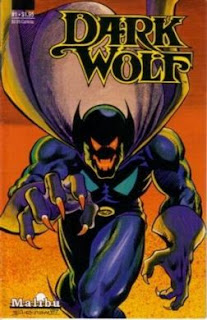Writer: R.A. Jones
Artist: Butch Burcham
Rating: Four of Ten Stars
For a millennium, the Lords of Life have plotted, schemed, and conducted unholy rituals--ever since they murdered a dryad and her human lover, using their life-force as the first step to gaining the total immortality possessed only by the gods. Now, in modern times, the Lords of Life are about to complete their task... and only the mysterious, ultra-violent figure of Dark Wolf stands in their way.

I doubt are many copies of "Dark Wolf" still floating around in the marketplace, but if you find any, you might want to leave it be.
While "Dark Wolf" is far from the worst that the black-and-white comics publishing boom of mid-1980s had to offer, it doesn't have much to recommend it. The story and its characters bring nothing new to the table, the scripting is weak and uninspired, and the artwork is amatuerish. (It actually gets worse as the series progresses, so I can't even compliment the artist on the growth of his talent... and that's too bad, because Burcham showed a nice sense of layout and visual storytelling, something which started to go by the wayside in the '80s.) Even the design of the costumed character at the front of the series--Dark Wolf--is lame. He's got Three Musketeer-style gloves with claws growing out of them?! Or, rather, they are claws on the covers, but inside they more often look like ballpoint pens sticking out of the tip of fat-fingered gloves.
Since issues of "Dark Wolf" aren't readily available anywhere, this may be a pointless review. Still, I re-read the series after rediscovering it in my vast collection, so I figured I'd not make that time spent a complete waste. And it does occur to me that those who haven't spent as much time as I have working with the fantasy/horror genre may indeed find "Dark Wolf" appealing.
If it's the first time you've encountered the sort of material within the series, you might find it interesting. Me, I am wondering how even 20 years ago I would have paid full price for the series. I'm hoping I got it as part of a review package, or maybe picked it out of a 25-cent bin at a convention.


























.jpg)
